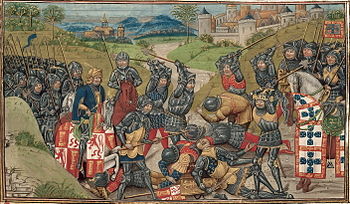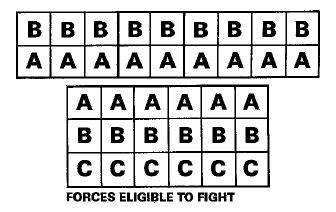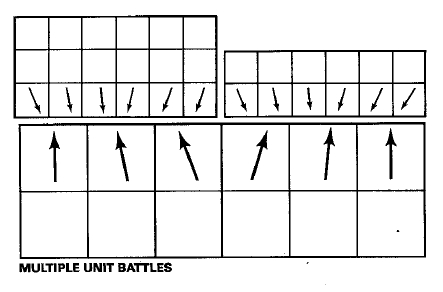8.0 MELEE PHASE

8.0 MELEE PHASE

| 8.1 Forces Eligible to Fight | 8.2 Weapon in Hand | 8.3 Determining Attack Ratings | 8.4 Melee Procedure | 8.5 Dice Conversions |
| 8.6 Multiple Attacks | 8.7 Killed and Wounded Figures | 8.8 Ending a Melee | - | - |
| - | - | - | - | BATTLESYSTEM |
Combat takes place between opposing units that are in
base-to-base combat during the Melee Phase.
PROCEDURE
Melee combat occurs between all
opposing units that are in base-to-base
contact during any part of the Melee
Phase. The side with init. determines
the order in which melees are resolved.
Each melee situation is resolved before
moving on to the next. All melee combat
is considered to be simultaneous. It is
easier for one side to make its attack
followed by the other, but do not remove
losses until after both sides have
completed their melee actions. Even
figures that are killed get to fight during
their final Melee Phase! (SPECIAL
NOTE: This applies to melee combat
only.)
[8.1] FORCES ELIGIBLE TO FIGHT
All figures in a unit that are in
base-to-base contact with one or more
enemy figures are eligible to fight in
melee.
If a unit is in closed formation, an
additional one figure to the left and one
figure to the right of the enemy's figures
can also fight.
If a unit in closed formation is using
pikes, each figure in the two rows
directly behind the row in base-to-base
contact with the enemy gives the unit one
extra attack. If the unit is using spears,
pole arms, or halberds, each figure in the
first row directly behind the row in
base-to-base contact with the enemy
gives the unit one extra attack.
A unit can fight multiple opponents.
Each unit vs. unit battle is treated as a
separate melee, and attacks are rolled
separately even when one unit is
involved in different melees. If figures in
a unit can fight in different melees, the
owning player must designate in advance
which figures are attacking which
targets.
A = FIGURE CAN FIGHT WITH ANY WEAPON
B = FIG. CAN FIGHT WITH SPEAR, POLE-ARM, HALBERD, OR PIKE
C = FIGURE CAN FIGHT WITH PIKE


Q: The rules list
bonuses for flank
and rear attacks. What prevents
opposing units from simply
running
around behind their enemies
and attacking them from
the rear?
Wouldn?t the defending unit
just
turn around to face the
enemy?
A: Units in the BATTLESYSTEM
supplement
can't just run around to
the rear of enemy
units in order to gain combat
bonuses.
The movement rules on pages
11-13 make
this a virtual impossibility.
Units can't
simply turn around to face
an enemy who
attacks from the flank or
rear, as large
numbers of people don't
react as quickly
as individuals do. There
is no penalty for
returning a rear attack
-- only a bonus for
making a rear attack. Some
creatures in
the defending unit can turn
around to
return the attack, but this
disrupts the
unit and makes defense more
difficult.
(127.67)
All members of a unit must be armed
with the same weapon in order to fight as
a unit, and they must have the same
weapon "in hand" in order to fight.
Unlike the AD&D or D&D games,
members of a unit can change weapons
at the beginning of any Melee Phase
without a penalty of time, movement, or
combat effectiveness. The owning player
simply announces that his unit is
changing weapons, and the change takes
place. A change in weapons can take
place even if the unit is in melee.
[8.3] DETERMINING ATTACK RATINGS
The base Attack Rating (AR) for a
figure or unit is determined before the
START of the game. It is modified
according to situational factors, and is
used to determine the effectiveness of an
attack (e.g., the amount of damage it
inflicts on the enemy).
To determine the base Attack Rating
for a figure or unit, first determine the
THACO (number "to hit Armor Class
0") according to AD&D or D&D
rules.
The THACO is based on the level, class,
and HD of the creature. Add or
subtract any AD&D or D&D game
bonuses or penalties to THACO (USE of
magic weapons, high DEX, weapon
non-proficiency, etc.)
Q: What is THAC0? How do I find it?
A: THAC0 is an acronym
for the phrase "To
Hit Armor Class 0." You
get the THAC0
number from the combat tables
of the
AD&D or D&D game
rules. Just look on
the appropriate attack table
and take the
numerical entry required
to hit AC 0.
(127.66)
When converting THACO to AR,
ignore the multiple 20s on the AD&D
game Attack Matrix and the D&D game
Character/Monster Hit Rolls Tables. For
example, if a figure or unit hits AC 1 on
a 20, its THACO for the purposes of
determining AR is 21. This applies only
in converting THACO to AR. For all
other purposes, the THACO remains 20,
with a note that the figure also hits AC 1
with a 20.
Once the base THACO is calculated,
add the Ratio Adjustment from the table
below to determine the Base AR.
Table 9: Ratio Adjustments for Determining AR.
| Figure Ratio | Adjustment |
| 10:1 | 0 |
| 5:1 | +5 |
| 2:1 | +10 |
| 1:1 | +15 |
Table 10: Attack Rating Modifiers for Melee Combat.
| Attacker is in open or skirmish formation | +1 |
| Any attacking figures are out of command (does not apply to skirmish units) | +1 |
| Defender occupies higher ground | +1 |
| Attacker is charging in closed formation | -1 |
| Attacking commander is fighting as part of the unit | -1 |
SPECIAL NOTE: Also add or subtract
all normal AD&D or D&D game
bonuses and penalties to THACO from
the adjusted AR.
EXAMPLES: -1 for negating defenders'
shield bonus (for attacking from flank),
-2 for attacking from the rear, +1 for
goblins and orcs attacking in daylight,
etc. Note that minuses are beneficial to
the attacker.
A. Determine the adjusted AR of attacker
and Armor Class (AC) of defender.
Subtract AC from AR.
B. Roll 2d6.
Add that number to the result from Step A.
C. Determine the type of damage
attacker does (1d6, 2d12, 1d4 + 1, etc.).
Use the rules in [8.5] DICE
CONVERSION to convert damage to a
single dice type (D6, D8, D12, etc.)
D. Cross reference the Dice Type column
found in Step C with the Attack Roll
found in Step B, using hte
BATTLESYSTEM Combat Results Table
(CRT) on the back cover of this booklet
(or on the Player Aid Cards). The
number found is the number of Hit Dice
of damage done by each attacking figure.
E. Multiply the Hit Dice of damage done
by the number of figures that attacked.
Determine how many enemy figures are
killed or wounded according to [8.7]
KILLED AND WOUNDED FIGURES.
F. The defending player makes any
attacks to which he is entitled, using the
same procedure.
G. After both players have completed
their attacks, remove all figures killed on
both sides, and place Wound markers on
all wounded figures.
EXAMPLE: A unit of 10 figures has an
adjusted AR of 17, and attacks an enemy
with an AC of 8. Subtracting AC from
AR gives a result of 9. A roll of 2d6 gives
a result of 7, for a total Attack Roll of 16
(9+7). The attackers are armed with
longswords, which do D8 damage. Cross
referencing the Attack Roll of 16 with the
D8 damage column gives a result of 6.
Ten figures do 10 x 6 HD of damage, for
a total of 60 HD.
Some weapons do damage that is
expressed in the roll of a single die (e.g.,
a dagger does 1-4, or D4, damage; a
longsword does either D8 or D12
damage). For such attacks, use the
Damage column on the CRT that
corresponds to the dice type of damage
done (e.g., D4, D8, or, D12).
Some weapons do damage that is
expressed in a multiple of a single die
(e.g., a broadsword does 2-8, or 2D4
damage; a bastard sword against large
targets does 2-16, or 2D8 damage). For
such attacks, use the Damage column on
the CRT that corresponds to the dice
type of damage done (e.g., D4, D6, D),
and multiply the result times the number
of dice done.
EXAMPLE: If a weapon does 2D8
damage, and the result in the D8 column
is 6, then each figure does 12 HD of
damage.
Some weapons do damage that is
expressed as a modified dice type (e.g., a
war hammer does 2-5, or D4 + 1 damage;
a holy longsword +5 does D8 + 5
damage). Damage plusses or minuses
change the column on which the results
are read, according to the following
procedure.
IF THE DAMAGE MODIFIER IS A
PLUS, shift one column to the right for
each plus (e.g., a +3 weapon gives 3
column shifts to the right). If the column
shifts past the D20 column, start again
with the D2 column and add the D20
column result to the column found after
"wrapping around" the table.
EXAMPLE: Damage of D6 + 1 is read
on the D8 column. Damage of D12 + 4 is
read on the D20 column. Damage of
D02 + 3 is calculated by wrapping around
the table three columns to the right, i.e.,
D2-D3-D4. The damage is the sum of the
D20 and the D4 column results. Damage
of D8 + 11 is determined by moving 11
columns to the right, i.e., D14-D16-D18-
D20-D2-D3-D4-D6-D8-D10-D12. The
damage is the sum of the D20 and D12
columns. If the column shift wraps
around more than once, e.g., D10 + 40,
keep adding the D20 result each time you
pass it. For example, damage of D10+40
would be read as the sum of
D20+D20+D20+D20+D8.
IF THE DAMAGE MODIFIER IS A
MINUS, shift one column to the left for
each minus. If the column would shift
past the D2 column, apply the D2 result.
EXAMPLE: Damage of D20-3 is read
on the D14 column. Damage of D6-4 is
read on the D2 column.
If a figure is entitled to multiple attacks
per melee round, it is entitled to multiple
attacks per BATTLESYSTEM game
Melee Phase. (EXAMPLEI: In the AD&D
game, a 7th level fighter is entitled to 3
attacks per 2 melee rounds, and to 7
attacks per melee round if fighting
monsters of less than 1 HD or 0 level
humans or semi-humans (PH, p.25).)
Use the same Attack Roll to calculate
damage for all attacks. If each attack
causes the same type of damage (e.g.,
D6, D8, or D4+1), multiply the damage
result by the # of attacks. If
different attacks do different types of
damage (e.g., a weretiger does
1-4/1-4/1-12, or D4/D4/D12), use the
same Attack Roll and add the various
damage results together to get the total
damage done.
[8.7] KILLED AND WOUNDED FIGURES
Each figure represents a certain
# of HD. It must lose all the HD
reprezented by the figure in order to
be killed.
EXAMPLE: A single orc figure (10 orcs) has 10 HD.
When a unit takes damage in melee, it
loses a certain # of HD. If the
# of HD of damage equals or exceeds
the # of HD of one
figure, one or more figures are killed.
EXAMPLE: A unit of 10 orc figures
has 100 HD. If an attack causes 30 HD
of damage, 3 orc figures are killed,
and are removed from play.
If the # of HD of damage is
not an exact multiple of the # of HD
of a single figure, a Wound may result.
A figure is Wounded if there is
damage => than 1/4 of
the HD of that figure, and less than
the total HD of the figure.
EXAMPLE: An attack against a unit of
10 orc figures does 35 HD of damage.
Three orc figures are killed with 5 HD
left over. Since 5 HD is more
than 1/4 of a single figure, one orc figure
is wounded. If the attack had done 31 HD
of damage, there would only have
been 1 HD left over. Since 1 HD is
less than 1/4 of a single figure, no wound
would result. The left-over damage is
simply disregarded.
Place a Wound marker on each
wounded figure. Wounds may only be
removed by magic, covered in the
Advanced Game.
A wounded figure moves and fights normally.
A figure can take only two wounds
before being killed. At the end of a Melee
Phase, no unit can have more than one
wounded figure. If a unit has two
wounded figures, remove one and return
the other to normal health.
EXAMPLE: During the previous Melee
Phase, 3 orc figures were killed and 1
was wounded. In the next Melee Phase,
the attacker did 25 HD of damage.
Two more orc figures are killed, and a
second wound is caused. Since two
wounds have now been placed, a third
orc figure is also removed.
Q: If the rules say
that a figure can
take two wounds before being
killed, does this mean that
a figure
can suffer two wounds, with
the
third wound killing it?
A: No. The second
wound kills the figure.
(127.66)
Q: What do you do
when the total
number of melee casualties
inflicted
on a unit exceeds the total
number of
figures that the unit has
in melee
(base-to-base) contact with
the
enemy?
A: According to designer
Doug Niles, a unit
must always remove all casualties
inflicted
during melee, even when
the number of
casualties exceeds the number
of figures
in melee contact. A unit
in any kind of
formation always fills gaps
during melee
(see pages 9-10 of the rulebook).
(127.66)
A melee ends when one or both units
have been completely destroyed, or when
one unit moves away from the other.
A unit that fails a Morale Check may
rout away from its opponent. A unit
may make a fighting withdrawal, giving
the opponent the opportunity to follow
or remain in place.
A unit can Flee a melee. To flee, a unit
makes an about face (no movement cost
in this case) and moves its full movement
rate away from the enemy. The enemy is
entitled to one free attack at the fleeing
unit with a -2 bonus "to hit" (attacking
from behind). The fleeing unit may not
fight back, but must make any Morale
Check required by losses it takes.
![]()
Reduce - Reuse - Recycle